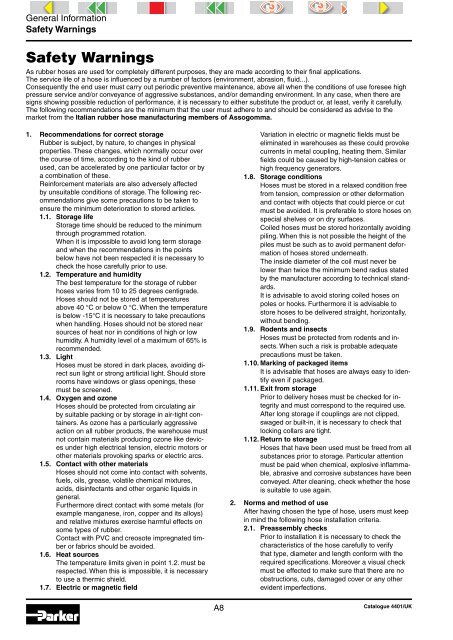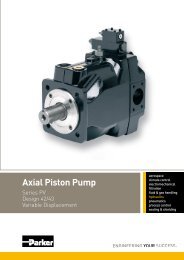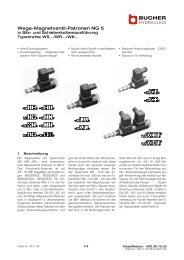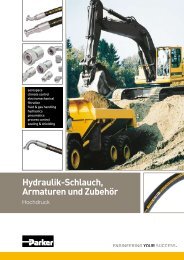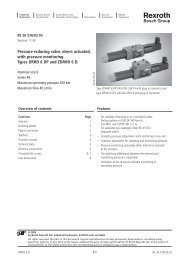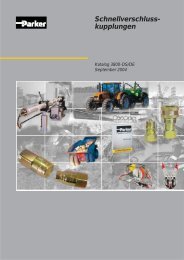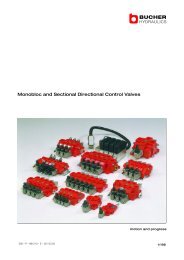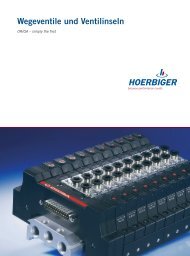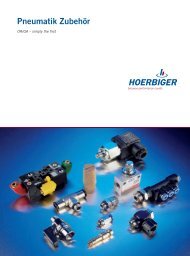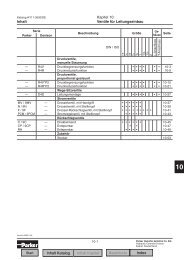PVC or PVC-PU Hose Hose Length - Rotec
PVC or PVC-PU Hose Hose Length - Rotec
PVC or PVC-PU Hose Hose Length - Rotec
Create successful ePaper yourself
Turn your PDF publications into a flip-book with our unique Google optimized e-Paper software.
General Inf<strong>or</strong>mation<br />
Safety Warnings<br />
Safety Warnings<br />
As rubber hoses are used f<strong>or</strong> completely different purposes, they are made acc<strong>or</strong>ding to their final applications.<br />
The service life of a hose is influenced by a number of fact<strong>or</strong>s (environment, abrasion, fluid...).<br />
Consequently the end user must carry out periodic preventive maintenance, above all when the conditions of use f<strong>or</strong>esee high<br />
pressure service and/<strong>or</strong> conveyance of aggressive substances, and/<strong>or</strong> demanding environment. In any case, when there are<br />
signs showing possible reduction of perf<strong>or</strong>mance, it is necessary to either substitute the product <strong>or</strong>, at least, verify it carefully.<br />
The following recommendations are the minimum that the user must adhere to and should be considered as advise to the<br />
market from the Italian rubber hose manufacturing members of Assogomma.<br />
1. Recommendations f<strong>or</strong> c<strong>or</strong>rect st<strong>or</strong>age<br />
Rubber is subject, by nature, to changes in physical<br />
properties. These changes, which n<strong>or</strong>mally occur over<br />
the course of time, acc<strong>or</strong>ding to the kind of rubber<br />
used, can be accelerated by one particular fact<strong>or</strong> <strong>or</strong> by<br />
a combination of these.<br />
Reinf<strong>or</strong>cement materials are also adversely affected<br />
by unsuitable conditions of st<strong>or</strong>age. The following recommendations<br />
give some precautions to be taken to<br />
ensure the minimum deteri<strong>or</strong>ation to st<strong>or</strong>ed articles.<br />
1.1. St<strong>or</strong>age life<br />
St<strong>or</strong>age time should be reduced to the minimum<br />
through programmed rotation.<br />
When it is impossible to avoid long term st<strong>or</strong>age<br />
and when the recommendations in the points<br />
below have not been respected it is necessary to<br />
check the hose carefully pri<strong>or</strong> to use.<br />
1.2. Temperature and humidity<br />
The best temperature f<strong>or</strong> the st<strong>or</strong>age of rubber<br />
hoses varies from 10 to 25 degrees centigrade.<br />
<strong>Hose</strong>s should not be st<strong>or</strong>ed at temperatures<br />
above 40 °C <strong>or</strong> below 0 °C. When the temperature<br />
is below -15°C it is necessary to take precautions<br />
when handling. <strong>Hose</strong>s should not be st<strong>or</strong>ed near<br />
sources of heat n<strong>or</strong> in conditions of high <strong>or</strong> low<br />
humidity. A humidity level of a maximum of 65% is<br />
recommended.<br />
1.3. Light<br />
<strong>Hose</strong>s must be st<strong>or</strong>ed in dark places, avoiding direct<br />
sun light <strong>or</strong> strong artificial light. Should st<strong>or</strong>e<br />
rooms have windows <strong>or</strong> glass openings, these<br />
must be screened.<br />
1.4. Oxygen and ozone<br />
<strong>Hose</strong>s should be protected from circulating air<br />
by suitable packing <strong>or</strong> by st<strong>or</strong>age in air-tight containers.<br />
As ozone has a particularly aggressive<br />
action on all rubber products, the warehouse must<br />
not contain materials producing ozone like devices<br />
under high electrical tension, electric mot<strong>or</strong>s <strong>or</strong><br />
other materials provoking sparks <strong>or</strong> electric arcs.<br />
1.5. Contact with other materials<br />
<strong>Hose</strong>s should not come into contact with solvents,<br />
fuels, oils, grease, volatile chemical mixtures,<br />
acids, disinfectants and other <strong>or</strong>ganic liquids in<br />
general.<br />
Furtherm<strong>or</strong>e direct contact with some metals (f<strong>or</strong><br />
example manganese, iron, copper and its alloys)<br />
and relative mixtures exercise harmful effects on<br />
some types of rubber.<br />
Contact with <strong>PVC</strong> and creosote impregnated timber<br />
<strong>or</strong> fabrics should be avoided.<br />
1.6. Heat sources<br />
The temperature limits given in point 1.2. must be<br />
respected. When this is impossible, it is necessary<br />
to use a thermic shield.<br />
1.7. Electric <strong>or</strong> magnetic field<br />
A8<br />
Variation in electric <strong>or</strong> magnetic fields must be<br />
eliminated in warehouses as these could provoke<br />
currents in metal coupling, heating them. Similar<br />
fields could be caused by high-tension cables <strong>or</strong><br />
high frequency generat<strong>or</strong>s.<br />
1.8. St<strong>or</strong>age conditions<br />
<strong>Hose</strong>s must be st<strong>or</strong>ed in a relaxed condition free<br />
from tension, compression <strong>or</strong> other def<strong>or</strong>mation<br />
and contact with objects that could pierce <strong>or</strong> cut<br />
must be avoided. It is preferable to st<strong>or</strong>e hoses on<br />
special shelves <strong>or</strong> on dry surfaces.<br />
Coiled hoses must be st<strong>or</strong>ed h<strong>or</strong>izontally avoiding<br />
piling. When this is not possible the height of the<br />
piles must be such as to avoid permanent def<strong>or</strong>mation<br />
of hoses st<strong>or</strong>ed underneath.<br />
The inside diameter of the coil must never be<br />
lower than twice the minimum bend radius stated<br />
by the manufacturer acc<strong>or</strong>ding to technical standards.<br />
It is advisable to avoid st<strong>or</strong>ing coiled hoses on<br />
poles <strong>or</strong> hooks. Furtherm<strong>or</strong>e it is advisable to<br />
st<strong>or</strong>e hoses to be delivered straight, h<strong>or</strong>izontally,<br />
without bending.<br />
1.9. Rodents and insects<br />
<strong>Hose</strong>s must be protected from rodents and insects.<br />
When such a risk is probable adequate<br />
precautions must be taken.<br />
1.10. Marking of packaged items<br />
It is advisable that hoses are always easy to identify<br />
even if packaged.<br />
1.11. Exit from st<strong>or</strong>age<br />
Pri<strong>or</strong> to delivery hoses must be checked f<strong>or</strong> integrity<br />
and must c<strong>or</strong>respond to the required use.<br />
After long st<strong>or</strong>age if couplings are not clipped,<br />
swaged <strong>or</strong> built-in, it is necessary to check that<br />
locking collars are tight.<br />
1.12. Return to st<strong>or</strong>age<br />
<strong>Hose</strong>s that have been used must be freed from all<br />
substances pri<strong>or</strong> to st<strong>or</strong>age. Particular attention<br />
must be paid when chemical, explosive inflammable,<br />
abrasive and c<strong>or</strong>rosive substances have been<br />
conveyed. After cleaning, check whether the hose<br />
is suitable to use again.<br />
2. N<strong>or</strong>ms and method of use<br />
After having chosen the type of hose, users must keep<br />
in mind the following hose installation criteria.<br />
2.1. Preassembly checks<br />
Pri<strong>or</strong> to installation it is necessary to check the<br />
characteristics of the hose carefully to verify<br />
that type, diameter and length conf<strong>or</strong>m with the<br />
required specifications. M<strong>or</strong>eover a visual check<br />
must be effected to make sure that there are no<br />
obstructions, cuts, damaged cover <strong>or</strong> any other<br />
evident imperfections.<br />
Catalogue 4401/UK


